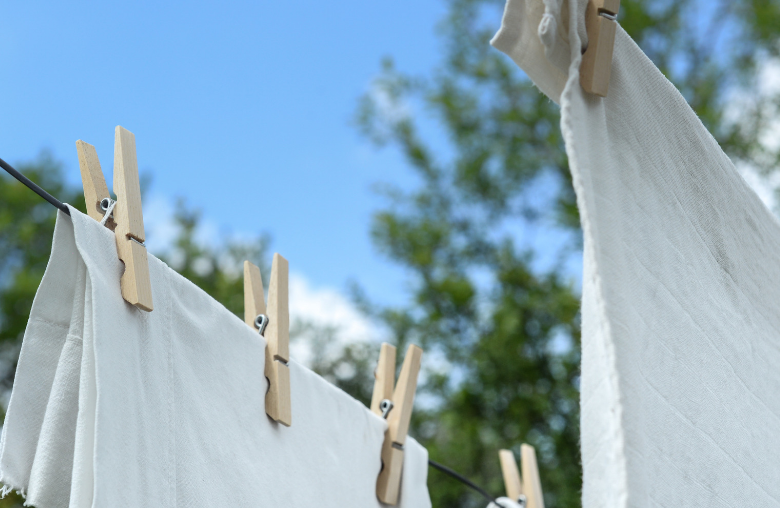Dirty Talk - Getting Down & Dirty In The Laundry
Posted by Naturally Safe Cosmetics on 6th Mar 2019
We all have dirty laundry, right? Unless you’re a nudist . . . but, no, even nudists have to wear clothes sometimes. And I am talking actual dirty laundry here, as in clothing, bedding and all manner of textiles, not the kind of dirty laundry we see aired on reality TV shows.
Yes, we all need to do the washing. But when it comes to laundry detergents, manufacturers have a little dirty laundry of their own, and this time I am talking dirty secrets. Why secrets? I say secrets because not all manufacturers provide a complete list of ingredients on the product packaging. That makes it somewhat difficult for consumers like you and I to know exactly what we’re using to clean our clothes. And, if we don’t know what’s in a product, then we have no way of knowing whether it contains ingredients that might be harmful to our health and that of the environment.

Many popular laundry products contain harsh chemicals. Image source: Canva
So, what ‘dirty’ ingredients can be found in your typical laundry detergent?
- SLS/SLES (Sodium Lauryl Sulphate/Sodium Laureth Sulphate/Sodium Lauryl Ether Sulphate) - these are surfactants which act as foaming agents and were originally developed as garage floor degreaser. These ingredients have been associated with skin irritation, organ system toxicity, neurotoxicity, possible mutations & cancer.
- 1,4-dioxane - a chemical which frequently contaminates SLS, it is a by-product of an ingredient processing method known as ethoxylation used to reduce the risk of skin irritation. In the short term, it has been linked to eye & nose irritation, in the long term liver & kidney toxicity. The State of California has declared that it can cause cancer and is potentially toxic to the brain & central nervous system. Interestingly, it is understood that 1,4-dioxane can be easily removed from products but testing has shown that often is not, as evidenced by its widespread presence in all manner of products, including personal care products like shampoos, body washes, lotions. Apparently, it never breaks down either.
- Phosphates - used to help soften the water and balance pH level. They are a combination of phosphorus, hydrogen and oxygen. Phosphates are big polluters of our water systems and, because phosphorus, hydrogen & oxygen are effectively ‘nutrients’ for both plant and animal life, phosphates are responsible for creating blue/green algae blooms and starving fish of oxygen.
- NPE (nonylphenol ethoxylate) - another surfactant, endocrine mimicker and disruptor. Tests have linked NPE to kidney & liver damage, decreased testicular growth, lower sperm count and more. Scarily, NPE is considered to be at least partly responsible for a variety of odd 'gender bending' phenomena seen in aquatic species.
- Optical/UV Brighteners - these purportedly whiten and brighten clothing and remove stains but actually just coat your clothes with a substance that reflects visible light, making clothes looker cleaner than they really are. They're known as 'stain hiders'. Optical brighteners are known eye, skin and lung irritants. They have also been associated with bacterial mutations and allergic reactions and are toxic to aquatic life.
- Chlorine/bleach - cause skin and lung irritation.
- Dyes - these are added purely to enhance the appearance of product. They serve no cleaning purpose and are responsible for contact dermatitis and irritation.
- Fragrance/Parfum - by law, the type of fragrance doesn't need to be disclosed on packaging. Artificial or synthetic fragrances can cause allergic reactions, rashes and chemical sensitivity. Some are known carcinogens and endocrine (hormone) disruptors.
What can you do to reduce the risk to your health and help our planet too?
1. If your laundry detergent (and other laundry cleaning products for that matter) includes a full list of ingredients on the packaging, I urge you to look up those ingredients and do your own research on any possible ill health or negative environmental effects. Then decide if you want to continue using them.
2. When buying laundry products, look for cleaners that are:
a. made from natural, plant-based ingredients like Australia’s own Ecologic brand
b. biodegradable
c. grey water safe
d. fragrance free or scented with pure essential oils
3. Switch your laundry liquid/powder for organic soapberries, which are raw, grey water safe, biodegradable, fully compostable, sustainable and fair trade.
Reference: EWG’s Skin Deep Cosmetics Database, naturallivingfamily.com, care2.com, choice.com.au, milacron.com
Disclaimer:
Neither the author nor Naturally Safe Cosmetics are health professionals. The information in this article has been compiled from the author’s own research and is of a general nature only. Nothing in this article is intended to diagnose, treat, cure or prevent any disease. If you are concerned about your personal health circumstances, please consult your GP or other healthcare professional.


